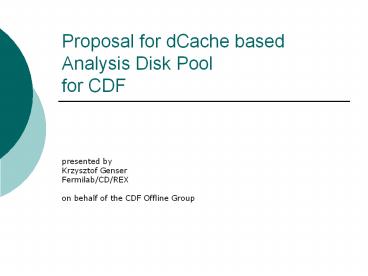Proposal for dCache based Analysis Disk Pool for CDF - PowerPoint PPT Presentation
1 / 14
Title:
Proposal for dCache based Analysis Disk Pool for CDF
Description:
Proposal for dCache based Analysis Disk Pool for CDF presented by Krzysztof Genser Fermilab/CD/REX on behalf of the CDF Offline Group – PowerPoint PPT presentation
Number of Views:87
Avg rating:3.0/5.0
Title: Proposal for dCache based Analysis Disk Pool for CDF
1
Proposal for dCache based Analysis Disk Pool
for CDF
- presented by
- Krzysztof Genser
- Fermilab/CD/REX
- on behalf of the CDF Offline Group
2
Outline
- The Problem Proposed Solution
- Deployment Process
- Collaborative and phased approach with feedback
from users and experts at each stage
3
The Problem
- Current solution used to support physics analysis
use cases (see Rays talk), i.e. 45 separate
file servers with static disk areas is - Fragmented and non transparent
- and therefore
- hard to oversee, use, support and manage
- Specialized version of rootd used to serve data
the person who was supporting it has left CDF
standard rootd will need investigation
4
Proposed Solution
- Replace the majority of the static disk space
with dCache based pool (the analysis disk pool) - Use it for large files for which dCache is known
to work well - Store small files, e.g. log files on other disk
based system e.g. on nfs mounted disks visible
from Interactive Login Pool nodes
5
Advantages
- Solution adopted/supported at Fermilab and within
HEP - Allows for unified support and expertise sharing
and accumulation - Global name space and space management
- more efficient use of disk resources
- more transparent maintainability
- Decoupling of the name and disk space
- Scalability
- Client software already used by CDF
6
Risks
- In a centralized, pnfs based system a small group
of users may inadvertently affect all users of
that system - Limited experience serving ntuples using dCache
on a large scale (many clients) - User expectations may not match system
performance/capabilities - Lack of personnel risk present for the existing
model as well as for the proposed one
7
Risk Management
- Staged deployment with reviews between stages
- Study impact of the use cases on the system
- Find system limits and communicate them to the
users - Monitor the system to make sure it stays within
the stable limits - Establish usage guidelines and limit exposures
when possible (e.g. limit pnfs mounts) - Using more widely supported solution
- Experiment modified rootd -gt dCache
8
Proposed Support Model
- Three tier approach
- Day-to-day operations and trouble shooting by CDF
power users CDF offline operations managers - Diagnosing difficult problems, evolving and
reconfiguring system when needed by a group from
a CDF institution (per a to be established MOU)
also serving as a point of contact between the
experiment and CD - Expert level consultations within to be agreed
upon limits by CD dCache development team
9
Proposed Support Model (contd)
- Hardware, OS support by REX/SA
- No change
- Given similarities of the system to the other
dCache systems one may want to revisit the
support model once the system reaches stable
level of operations and the support effort is
known
10
Deployment Plan
- Staged approach Three initial phases
- Prototyping
- Pre-production
- Production
11
Phase I Prototyping
- Time scale till end of January 2006
- Goals
- Develop resource loaded schedule
- Understand use cases and system requirements
- Understand technical characteristics and limits
of the system (using 50TB of disks) - Recruit and train power users (with needs after
winter conferences) - Train CDF Offline Operations Managers
- Establish sufficient system monitoring
- Develop usage rules and guidelines
- Investigate a possibility of building a common
knowledge base (repository?) to be shared among
CD, CDF, CMS, MINOS - Develop specification for the hardware to be used
in phase II - Develop support agreements for phase II
- Hold/pass pre-production readiness review
12
Phase II Pre-Production
- Time scale 4 months
- Goals
- Deploy production hardware (system size 100TB)
- Establish automatic system monitoring
- Define/Perform load tests at the anticipated
production level - Gradually expand user base to the full
collaboration with the understanding that each
expansion may need to be reverted should system
become unstable use authentication mechanisms to
limit access - Revise usage rules and guidelines as needed
- Develop support agreements for phase III
- Hold/pass production readiness review
13
Phase III Production
- Desirable Time Scale end of Tevatron Shutdown
July 2006 - Goals
- Maintain stable operations (system size 100TB)
- Allow for user base expansion within stable
limits - Evolve the system to support approved use cases
- Perform needed tests during scheduled downtimes
to validate configuration and policy changes
14
Summary
- The process of arriving at a stable Analysis Pool
solution was described - The staged deployment with the reviews between
the phases should help risk mitigation and with
managing user expectations































